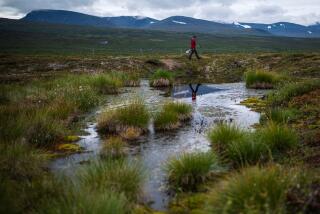Melting of Arctic Ice Tied to Global Warming
- Share via
The giant arctic ice cap may be melting as a result of global warming, according to a new paper by an international team of researchers.
An analysis using complex computer programs that mimic the climate system indicates only a 2% chance that arctic melting over the last 19 years is a result of natural climate changes, according to the paper appearing in today’s edition of the journal Science.
Also, there only is a 0.1% chance that the melting over the last 46 years is natural, according to the team led by Konstantin Vinnikov of the University of Maryland.
In recent years scientists have become increasingly concerned about the possibility that chemicals released into the atmosphere by industry are causing the climate to grow warmer, although some contend that the changes are part of natural variability.
Vinnikov’s team concentrated on satellite measurements of sea ice in the Arctic taken since 1978, showing an overall decline in ice area larger than the state of Texas.
They used computers in Princeton, N.J., and at the Hadley Center in Britain to calculate the probable normal changes in the Earth’s atmosphere over long periods.
They then studied computer simulations that include greenhouse gas increases, tending to warm the atmosphere, and aerosol increases, tending to cool the atmosphere.
The model results with these human-induced changes included were a much better match with the observed sea ice decreases than the model results simulating natural variability.
The result, the team reports, “strongly suggests that the observed decrease in Northern Hemisphere sea ice extent is related to [human-caused] global warming.”
The probability that melting under normal conditions would equal that seen in the last 19 years was less than 2%, they said, and the likelihood that it would equal the melting over the last 46 years was under 0.1%.
In addition to the University of Maryland, Rutgers University, the National Oceanic and Atmospheric Administration, the University of Illinois, NASA, the Hadley Center in Great Britain and the Arctic and Antarctic Research Institute in Russia participated in the study.






